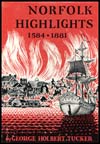Chapter 53
Education in Old Norfolk
Although a lot of the east side of "the street that leadeth into the woods," that later became Church Street and is now St. Paul's Boulevard, was provided for a schoolhouse by the Lower Norfolk County authorities when Norfolk was laid out in 1680-81, there was no school building on the property until around 1761.
In the intervening eighty years there were four ways a child could learn his "three R's" in the borough.
Well-to-do citizens provided private tutors for their children; a parish school for boys was conducted off and on by the ministers or parish clerks of Elizabeth River Parish; an enterprising lad could be apprenticed to a merchant to learn arithmetic, spelling, bookkeeping and how to write a legible hand from a senior mercantile clerk; or a girl could obtain the rudiments of an education, "needlework, and marking on a sampler" by attending what was then known as a "Dame's School," usually operated in their own homes by literate but impecunious widows or spinsters.
The first step toward organized public education in the borough was taken in 1728, when Samuel Boush I and Thomas Newton, acting as trustees for the Norfolk County Court for unsold public lands in the town, conveyed half of the lot originally set aside in 1680-81 for a school to Samuel Boush II, Nathaniel Newton, and Samuel Smith who agreed to erect a schoolhouse on the property and to employ a master. As nothing was done, however, the Virginia General Assembly took matters into its hands in 1752 and authorized the Norfolk County Court and the Norfolk Borough Council jointly to hire a schoolmaster and establish a Grammar School on the still vacant schoolhouse lot.
As this produced no action, the Assembly passed a new act in 1762, vesting the sole control of the proposed Grammar School in the borough council. This act, passed in March 1762, states, " . . . a schoolhouse hath been built on the said lot . . ." As far as can be determined now, this was the first schoolhouse erected for that purpose in the borough. This was the beginning of the present Norfolk Academy.
As this building presumably was destroyed at the beginning of the Revolutionary War when Norfolk was burned by the British and Virginia forces, the aldermen and common council of the borough appointed commissioners on December 6, 1785, to " . . . agree with some person or persons to rebuild the free school . . ." The rebuilt school, known for the first time as the "Norfolk Academy" and headed by the Reverend Walker Maury, opened in 1786, at which time it ceased to be a free school, a tuition fee being charged.
Its curriculum consisted of reading, writing, arithmetic, bookkeeping, English grammar, geography and the use of the globes, and Latin, Greek, and French. Pupils of the first class were distinguished by a broad black ribbon thrown over the right shoulder and under the left, while those in the lower grades wore a blue ribbon in the buttonholes of their coats.
The second school building on Church Street opposite St. Paul's Episcopal Church was used until the opening of the Old Norfolk Academy building on Bank Street in 1841, with John P. Scott, a fiery-tempered Irishman as headmaster. Tradition says that when the weather was warm and the boys were obstreperous, Scott would swoop down on the culprits and toss them out of the nearest window.
Besides the Academy there were many other privately operated schools in Norfolk during the early Nineteenth Century, notably the Lancastrian School (1815-1856), one of the many monitor-operated, non-secterian institutions of its kind in the United States, established by Joseph Lancaster (1788-1838), an English educator and a member of the Society of Friends.
All of these privately owned Norfolk schools operated on a tuition basis, however, making it difficult for the average poor child to obtain even the rudiments of an education.
Finally, this condition was changed in 1850, when Norfolk by an act of the Virginia Assembly was authorized to establish a free public school system. It was not until 1858, however, that Norfolk's first four public schools for any white person between the ages of six and twenty-one were opened, with Thomas C. Tabb (1803-1873) as the city's first public school superintendent.
Chapter
54
Norfolk's Farewell to a Hero
Norfolk Highlights 1584 - 1881

See the "Table of Contents" for links to every chapter in Norfolk Highlights 1584 - 1881 by George Holbert Tucker.
